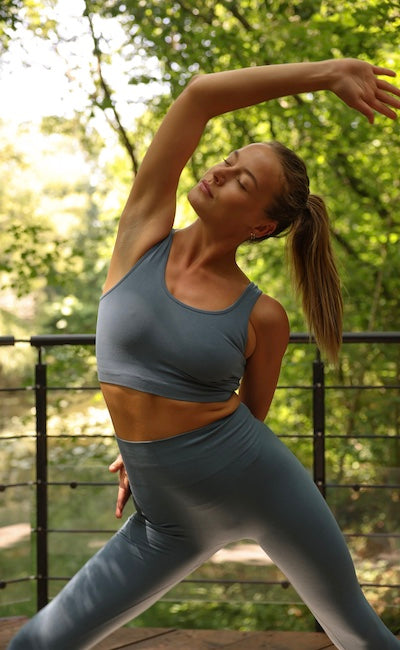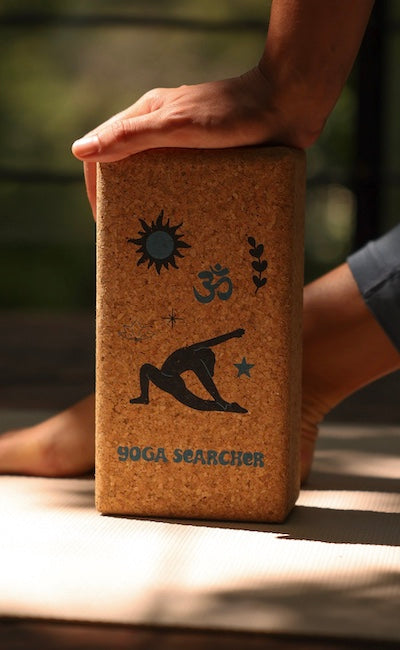Discover why a yoga block is essential for your practice: support, alignment, relaxation and safe progression.
Are you new to yoga and wondering why a yoga block is essential? This small piece of equipment can revolutionize your practice and help you reach new heights in your postures.
A yoga block is a versatile accessory that provides additional support and stability during your sessions. Whether you're a beginner or advanced in your practice, adding a yoga block can help you find better alignment, deepen your stretches, and build strength.
By using a yoga brick , you can adjust the height and position of your posture to suit your individual needs. It can also be used as a support for your back, hands, or feet to help you maintain balance and strengthen your muscles.
Don't underestimate the power of a yoga block in your practice. It can provide valuable support and help you progress in your poses, while also helping you avoid injury. So don't wait any longer, get yourself a yoga block and discover for yourself the benefits it can bring to your practice.
What is a yoga brick?
A yoga block is a prop designed to help practitioners improve their technique and adapt poses to their flexibility and strength levels. Typically made of foam, cork, or wood, the block is an essential tool that provides additional support in various positions. Its rectangular shape allows it to be used in a variety of ways, whether to elevate a body part or provide support to specific joints.
The main idea behind using a yoga block is to make poses accessible to everyone, regardless of their skill level. For beginners, it can make learning poses easier by providing a point of support and improving body alignment. For advanced yogis, it can help deepen stretches and poses, while also providing opportunities to experiment with new variations of classic poses.
In short, the yoga block is a versatile tool that can transform your practice. It's often underestimated, but using it can lead to a better understanding of your body and its needs. Whether you're new to yoga or a seasoned practitioner, incorporating a block into your practice can enrich your yoga experience.

The Benefits of Using a Yoga Brick
Maintaining Alignment
One of the main benefits of using a yoga block is that it improves safety when performing poses. By providing additional support, it helps maintain proper alignment, reducing the risk of injury. Poses that might otherwise seem too difficult or uncomfortable become more accessible, allowing practitioners to focus on their breathing and well-being without fear of injury.
Supports Progress
Additionally, yoga blocks promote progression in the practice. They allow you to explore variations of postures that may seem unattainable. For example, if you can't touch the floor with your hands during a pose, using a block to elevate your hands can help you maintain alignment while still allowing you to feel the benefits of the stretch. This encourages a deeper, more mindful practice, where each movement is executed with intention and attention.
Promotes relaxation
Finally, using a yoga brick can also promote relaxation. In certain poses, a brick can act as a support for the back or head, allowing for the complete release of muscular tension. This creates a space where the body can relax and the mind can find calm and serenity. By incorporating this accessory, you can enrich your practice by combining effort and relaxation.
The different uses of a yoga brick
The uses of a yoga block are varied and can be adapted to most postures. For example, in postures like triangle or warrior 3 pose, the blocks can be placed under the hands to provide support and help maintain balance. This is especially useful for beginners who may have difficulty reaching the floor with their hands.
Additionally, bricks can also be used to intensify stretches. In the forward bend pose, for example, placing a brick under your feet helps increase the amplitude of the stretch while ensuring your back remains straight. This provides a sense of depth in the stretch and helps develop flexibility without the risk of injury.
Finally, a brick can also be used for relaxation. In poses such as Child's Pose or Supported Bridge Pose, a brick placed under the head or at the sacrum can provide additional comfort. This allows your body to fully relax, promoting better recovery after an intense yoga session. By incorporating a brick into various poses, you'll discover new ways to deepen your practice.
How to Choose the Right Yoga Brick
Choosing the right yoga brick depends primarily on your personal needs and preferences. First, it's essential to consider the brick 's material. Foam bricks are lightweight and ideal for beginners, as they provide good support while being easy to handle. Cork bricks , on the other hand, are sturdier and offer better grip, which can be beneficial for more advanced practitioners.
Next, the size of the brick is also an important factor to consider. Standard bricks typically measure 23 x 15 x 10 cm, but there are larger or smaller options. If you are taller or need extra support, a thicker brick may be more appropriate. On the other hand, if you are shorter or looking for a lighter option, a thinner brick may be suitable.
[ApSC sc_key=sc2860290926][/ApSC]
Finally, it can be helpful to test out several types of blocks before making your choice. Every practitioner has different preferences when it comes to comfort and support, so taking the time to try out different options can help you find the one that works best for you. Whether in a store or at a yoga studio, feel free to experiment with different materials and sizes to find the perfect block for your practice.
Yoga Exercises and Poses with a Brick
Chair Pose
There are a multitude of yoga poses that can be enhanced through the use of a yoga brick . For example, in chair pose, a brick can be placed between the thighs to encourage activation of the lower body muscles while maintaining proper alignment. This not only helps strengthen the legs, but also stabilizes the posture.
The Pyramid Pose
Another classic pose where a brick can be helpful is pyramid pose. By placing a brick under the hand that touches the floor, you can reduce tension in your back and allow for better hip opening. This helps deepen the stretch without compromising posture, allowing you to focus on your breathing and alignment.
The Plow Pose
Finally, plow pose is another pose where using a brick can make a big difference. By placing a brick under your back, you can support your spine while working on opening your shoulders and stretching your legs. This makes it easier to access the pose while keeping your neck and back safe. With these few examples, it's easy to see how a brick can enrich your yoga practice.
How to Incorporate a Yoga Block into Your Daily Practice
Incorporating a yoga block into your daily practice can be done gradually. Start by adding the block to the poses you already practice. For example, if you usually do downward-facing dog, try placing a block under your hands to see how it changes your experience. You might be surprised by the support and stability it provides.
Additionally, try experimenting with poses you haven't yet mastered. Use the brick as a tool to explore new pose variations. For example, in Half Moon Pose, a brick can be placed under your bottom hand to aid balance and allow you to focus on your body alignment. This can also encourage you to stay in the pose longer, promoting greater strength and flexibility development.
Finally, don't forget to include the brick in your relaxation sessions. After an intense session, use it to support your back or head in poses like supine or child's pose. This can help you fully relax and enjoy the benefits of your practice. By gradually incorporating the brick into your routine, you'll quickly discover how much it can enrich your yoga experience.

Common Mistakes to Avoid When Using a Yoga Block
When you start using a yoga block , it is important to be aware of some common mistakes. One of the most common mistakes is not using the block properly. Sometimes, practitioners tend to feel embarrassed about using a block , thinking that it means they are not "good enough." In reality, the block is a tool that promotes progression and improvement, and its use should not be perceived as a failure.
Another common mistake is neglecting alignment. Even with a brick , maintaining good posture is essential to avoid injury. Make sure you're using the brick to support your body properly and listening to your body's signals. If a posture doesn't feel right, it's important to readjust or use the brick in a way that works better for you.
Finally, it's crucial not to rush into postures. Using a block is designed to promote a mindful and safe practice. Take the time to explore each posture, allowing yourself to adjust the block and find the right support. This will help you connect more deeply with your body and get the most out of your yoga practice.
Additional Health and Wellness Benefits of a Yoga Block
In addition to the physical benefits, a yoga block can also provide psychological and emotional benefits. By promoting greater body awareness, it helps practitioners connect with their bodies on a deeper level. This connection can lead to better stress management and increased concentration, which is beneficial both in yoga practice and in daily life.
Additionally, using a brick can also encourage meditation and relaxation. By providing additional support, it allows you to maintain meditation postures for longer periods without discomfort. This can be particularly helpful for those who struggle with pain or tension during meditation, allowing them to experience deeper peace of mind.
Finally, incorporating a brick into your practice can also strengthen your commitment to your overall well-being. By taking care of your body and allowing yourself to explore the postures at your own pace, you'll cultivate a positive attitude toward your practice and your overall health. This can contribute to a better quality of life, allowing you to live each day with greater energy and a sense of well-being.
Conclusion - The Importance of Adding a Yoga Brick to Your Practice Equipment
In short, incorporating a yoga block into your practice is an essential step to enhance your experience. Whether you're a beginner or a seasoned practitioner, this versatile accessory can provide valuable support, promote better alignment, and explore new posture variations. By using a block , you give yourself the opportunity to progress at your own pace while avoiding injury.
The benefits of a yoga block go far beyond the physical. It can also enhance your mental and emotional well-being, helping you find a deeper connection with your body and cultivate a positive mindset. By allowing you to focus on your breathing and alignment, you can fully reap the benefits of the practice.
Don't wait any longer to add a yoga block to your equipment. Whether in the studio or at home, this tool can transform your practice and help you reach new heights in your yoga journey. Invest in a quality block and discover for yourself the many ways it can enrich your yoga experience.


